Updated: Oct 20, 2022
10 Ergonomic Tips for Wearing a Backpack Properly
Whether carrying textbooks to school, a laptop to work, or outdoor gear on a hiking trip, a backpack is the most convenient means of transportation. But poor backpack wearing habits can make wearing a backpack a less than positive experience. Many people overlook the amount of weight they carry around when wearing a backpack, and they seldom take the time to get their backpack set up properly for a positive wearing experience.
These improper backpack wearing habits lead to unnecessary neck, shoulder, and back pain. But wearing a backpack doesn’t have to be a negative experience. By implementing the principles of ergonomics, you can turn your backpack wearing experience into a positive one. So here are 10 ergonomic tips for wearing a backpack properly.
How to Wear a Backpack Properly
- Use a backpack with wide, well-padded shoulder straps. Narrow straps can dig into your shoulders and cause discomfort.
- Always use two shoulder straps instead of one. This helps to distribute weight equally.
- Place heavy items towards the back of the backpack, closest to your back. Moderate weight items can be placed in the middle section, and lightweight items should be placed furthest away from your back, towards the front of the backpack.
- Keep in mind that your backpack should remain symmetrical in shape while packing in order to avoid unequal weight distribution.
- Your backpack should not weigh more than 10% of your total bodyweight. That means a person who weighs 100 pounds should carry a backpack that weighs no more than 10 pounds. If you don’t have a scale available to check the backpack weight, then self-assess how the weight feels. If your body tells you it feels too heavy, then lighten the load.
- Ensure that the bottom of the backpack rests in the curve of the lower back. This helps to maintain an upright posture.
- Check that the top of the backpack is two inches below the shoulder blades and that the bottom is at waist level or just above waist level.
- When wearing your backpack, the fit should be snug. This helps to reduce additional force. The further a heavy object is from the body, the more force is required to lift it.
- If your backpack comes with a chest clip and a hip belt, use it. This will help reduce the amount of weight distributed to the shoulders and neck.
- Lastly, choose a backpack made of lightweight but durable material to decrease the overall weight of the backpack.
Other Tips for Properly Wearing a Backpack
- If you carry a water bottle, carry it empty and fill it when you arrive at your destination. This can make a big difference in reducing the weight of your backpack, especially for students who are walking to and from school or walking on campus.
- Remove unnecessary objects from your backpack daily. The individual objects themselves may not weigh much, but the collective weight of them all adds up quickly.
- Sometimes it is impossible to reduce the weight of your backpack because you simply have too much to transport. If the weight of the items in your backpack equals more than 10% of your body weight and nothing else can be removed, consider using a backpack on wheels.
For more information on proper backpacking wearing, check out this helpful resource from the American Occupational Therapy Association. Also, check out our YouTube video below for a visual representation of the blog!



